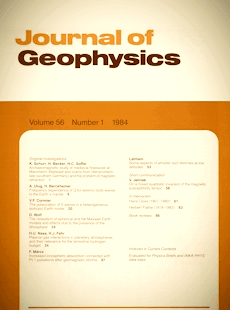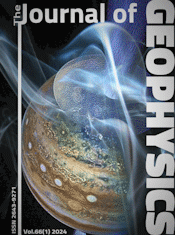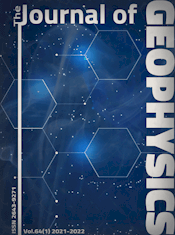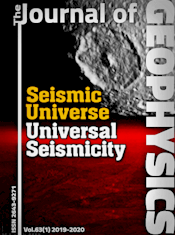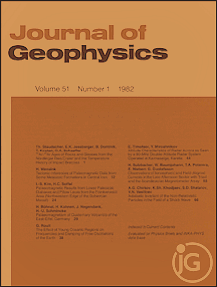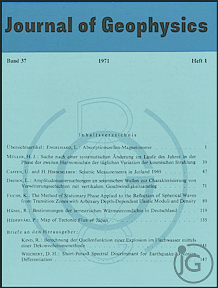The relaxation of spherical and flat Maxwell Earth models and effects due to the presence of the lithosphere
Article Sidebar
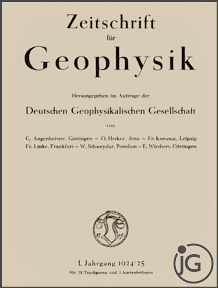
Vols. 1-18 (1924-1944), ISSN 0044-2801
Main Article Content
Abstract
The radial surface deflection of a spherical Earth model appropriate to time scales characteristic of glacial loading is compared with the associated half-space response. For that purpose the analytical solution for a Maxwell sphere surrounded by a thick elastic shell is derived under the assumption of incompressibility. The half-space approximation is deduced as a special case directly from the spherical solution. Comparison of the response spectra, for different thicknesses of the elastic shell, reveals only minor differences. In the spatial domain, the half-space approximation may, nevertheless, diverge significantly from the spherical solution. For a disk load radius R = 800 km (Fennoscandia), the half-space approximation is adequate, whereas it is usually inappropriate if R = 1600 km (Laurentia). The sensitivity of the response to the thickness of the elastic shell is also investigated. For R = 800 km, the surface deflection in the central region below the load is fairly diagnostic of the shell thickness. If R = 1600 km, the peripheral region is more sensitive to this parameter.
 ARK: https://n2t.net/ark:/88439/y005336
ARK: https://n2t.net/ark:/88439/y005336
Permalink: https://geophysicsjournal.com/article/210
Article Details
References
Bullen, K.E. (1963) An introduction to the theory of seismology, 3rd edn. Cambridge University Press
Cathles, L.M. (1975) The viscosity of the Earth's mantle. Princeton University Press
Crittenden, M.D. jr. (1963) Effective viscosity of the Earth derived from isostatic loading of Pleistocene Lake Bonneville. J. Geophys. Res. 68, 5517-5530
Dragoni, M., Yuen, D.A., Boschi, E. (1983) Global postseismic deformation in a stratified viscoelastic Earth: effects on Chandler wobble excitation. J. Geophys. Res. 88, 2240-2250
Haskell, N.A. (1935) The motion of a viscous fluid under a surface load. Physics 6, 265-269
Jeffreys, H. (1976) The Earth, 6th edn. Cambridge University Press, New York
Lebedev, N.N. (1972) Special functions and their applications. Dover, New York
Love, A.E.H. (1911) Some problems of geodynamics. Cambridge University Press
Love, A.E.H. (1927) A treatise on the mathematical theory of elasticity, 4th edn. Cambridge University Press
McConnell, R.K. (1968) Viscosity of the mantle from relaxation time spectra of isostatic adjustment. J. Geophys. Res. 73, 7089-7105
Nakiboglu, S.M., Lambeck, K. (1982) A study of the Earth's response to surface loading with application to Lake Bonneville. Geophys. J. R. Astron. Soc. 70, 577-620
Peltier, W.R. (1974) The impulse response of a Maxwell Earth. Rev. Geophys. Space Phys. 12, 649-669
Peltier, W.R. (1980) Ice sheets, oceans, and the Earth's shape. In: Moerner, N.-A. (Ed.) Earth rheology, isostasy, and eustasy, pp. 45-63. Wiley, New York
Peltier, W.R. (1982) Dynamics of the ice age Earth. Adv. Geophys. 24, 1-146
Peltier, W.R. (1984) The thickness of the continental lithosphere. J. Geophys. Res. (In press)
Stichter, L.B., Caputo, M. (1960) Deformation of an Earth model by surface pressures. J. Geophys. Res. 65, 4151-4156
Sneddon, I.A. (1951) Fourier transforms. McGraw-Hill, New York
Walcott, R.I. (1970a) Flexural rigidity, thickness, and viscosity of the lithosphere. J. Geophys. Res. 75, 3941-3954
Walcott, R.I. (1970b) Isostatic response to loading of the crust in Canada. Can. J. Earth Sci. 7, 716-727
Watson, G.N. (1944) A treatise on the theory of Bessel functions, 2nd edn. Cambridge University Press
Wolf, D. (1984a) Thick plate flexure re-examined. Geophys. J. R. Astron. Soc. (In press)
Wolf, D. (1984) On the relation between two-dimensional and axisymmetric loads in plate flexure problems. J. Geophys. 54, 232-235
Wu, P., Peltier, W.R. (1982) Viscous gravitational relaxation. Geophys. J. R. Astron. Soc. 70, 435-485


